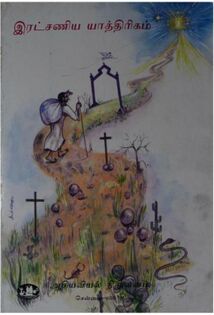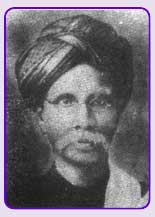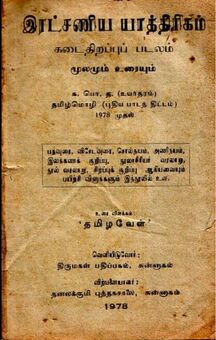Ratchanya Yathrigam
இந்தப் பக்கத்தை தமிழில் வாசிக்க: இரட்சணிய யாத்திரிகம்
Ratchanya Yathrigam (Ratchanya Yathreegam) is a Christian epic written in Tamil. It is modeled after The Pilgrim’s Progress (1678) by John Bunyan and written in traditional verse style by H.A. Krishna Pillai.
Publication
Ratchanya Yathrigam was published in Narbothagam magazine, released from Palayamkottai, as a 13 year series.
It was first published in May 1894 by Christian Literary Association.
Author
H. A. Krishna Pillai was born in Karaiyiruppu, a small village in the Tirunelveli district in 1827. His was a Vaishnavite family from Vellalar clan. He received baptism at the age of thirty and became a Christian. He assumed the name, Henry Alfred Krishnapillai thereafter.
Summary of the Text
Ratchanya Yathrigam explains the heaven bound journey of a Christian called 'Anmeehan'. Even though it is written in a biographic style, it is a metaphorical story. It talks of all the events of a soul's pilgrimage towards redemption as described in Christianity.
The protagonist of Ratchanya Yathrigam is Kiruththuvan (Christian) or Aanmeehan (spiritual person). His guru is Narcheiythiyaalan (Evangelist) and friend, Mennenjan (soft natured person). Aanmeehan meets Viyakkiyaani (interlocutor) and is encouraged by his speeches. The journey on the path of righteousness is not easy and there are troubles and trials that lead the traveler astray. Yet the protagonist realizes that he should advance in the pilgrimage with steadfast resolve. When he sees a Christian hill, praising God he advances further and stops to rest in an inn. There he is cared for by four women named Viveki (wise one), Yugi (clever one), Bakthi (pious one) and Sinehithi (friendly one). Bakthi explains the passion of Christ and the redemption that it can bring.
He befriends Nambikai (Faith). He traverses more challenges and finally crosses the river of death and they both reach Uchitha Pattinam (The ultimate town). There God’s angels welcome them. They witness the scene of Jesus seated in the throne and are elated. This is the reason why the book gets the name Ratchanya Yathrigam, meaning redemptive pilgrimage.
Creation
H. A. Krishna Pillai developed interest in Christianity while he was working as a Tamil teacher in a college at Sayarpuram run by G. U. Pope. As he fervently read Christian books, he came across Pilgrim’s Progress by John Bunyan (1628 - 1688) and became deeply interested in it. Krishna Pillai felt that the book was talking about his own life and wrote the epic based on the two part book.
Instead of translating the work, he wrote this important Tamil Christian literary work by adding aspects of Tamil culture.
This book contains 3800 verses. It contains 21 special poems that have been written in the style of Yamagam (repeated stanza with different meanings), Thiribu (alternate meanings), Siledai (paronomasia), Madakku (repeated start to verses) which were considered as marks of a great poet at that time. The book is divided into five Paruvams (sections or volumes), namely, Aathi Paruvam (Beginning), Kumaara Paruvam (Childhood/Teenage), Nithaana Paruvam (Calmness),Aaranya Paruvam (Wilderness), Ratchanya Paruvam (Redemption). These sections are made up of a total of 47 chapters.
In this bookk, H. A. Krishna Pillai adapted the Shivite Devaram poetry (known for its poetic metre) and wrote 144 verses based on them. Adapting Devarams meter and style, he inserted these verses into various chapters of the collection, giving them the same title - Devaram.
H.A. Krishna Pillai likens the purpose of the book to "a rare medicine that provides redemption to the soul of the entire human race"
Literary Significance
This book was a Christian literary work, written in the grammar of traditional epics. However, it also contained difficult prose typical of the "little magazine" movements of later years. The language and stylistic devices used were quite traditional.
Links
✅Finalised Page



